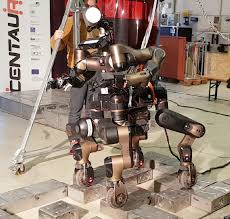Radioactive Waste 653 - CENTAURO Robot Being Developed To Operate In Radioactive Environments
CENTAURO robot.jpg

Handling radioactive materials is dangerous for human beings. I have mentioned work on various robots in the past that are intended for use in nuclear reactors and nuclear waste facilities. Following the March 2011 nuclear disaster in Japan, some robots were deployed to deal with the aftermath. These robots were primitive and often ineffective. Some were damaged and rendered inoperable by radioactivity. However, work has continued and robots for the nuclear industry are rapidly evolving.
Professor Sven Behnke is a robotics expert at the University of Bonn who is working on a robot called Centauro because it has four legs and two arms. He and his team are developing a robust teleoperated disaster response system. Their robot is remotely operated by a human being in a safe remote location. It has a suite of sensors that gather detailed information about its environment and relay that information back to its operator.
Behnke said, “The main operator controls the robot through a telepresence suit which measures the motions of the operator's arms, wrists and fingers and transfers them to the robot. A head-mounted display worn by the operator allows them to see in 3D what the robot sees from its own perspective. The robot has a centaur-like body plan with four articulated legs ending in steerable wheels.”
Centauro weights about two hundred pounds and is about five feet tall. It has frame made of light-weight materials such as aluminum and a plastic skin that was 3-D printed. The robot’s four legs make it more stable than a bipedal robot. It is able to rotate at the hip, the knee and the ankle. This means that the robot can assume various postures and can navigate in a complex and challenging environment.
Centauro has two arms attached to its upper body. Each arm ends in a multi-figured hand. The robot is able to pick up objects, manipulate tools and open and close doors. The robot is tele-operated, but it does have some degree of autonomy. It can be given simple orders such as to move to a particular location or to pick up a particular object. The robot is able to plan and execute the requested actions without further instruction or remote control.
Last year Centauro was tested in real-world situations. The nuclear disaster response provider Kerntechnische Hilfsdienst GmbH set up challenging scenarios for the robot. It was able to climb stairs, move around debris, overcome gaps, unlock a door, operate valves, manipulate tools and handle other tasks. Behnke said, “The Centauro disaster-response system provided the high degree of flexibility needed for realistic missions.” Behnke is confident that his robotic technology will eventually play a major role in disaster relief efforts, but it has not had to deal with high radiation levels yet in its tests.
More than ninety nuclear reactors have been permanently shut down across the European Union. More reactors are scheduled to be decommissioned. The E.U. Commissions has proposed the allocation of one billion three hundred and sixty-seven million dollars for nuclear safety. There are nearly five million tons of legacy nuclear waste in the U.K. alone. Cleaning it up is the biggest and most complicated environmental remediation challenge in the E.U.